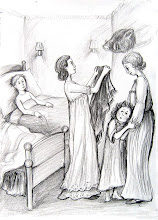Kelley, Alice van Buren. To The Lighthouse: The Marriage of Life and Art. Twayne Publishers, Boston, 1987.
Among the many important influences in Virginia Woolf’s life, one of the primary ones was her interest in art and art theory. Woolf developed a close friendship with the prominent artist and art critic Roger Fry, who was also a fellow member of the Bloomsbury Group. In To The Lighthouse: The Marriage of Life and Art, Alice van Buren Kelley explores the friendship between Woolf and Fry, and the similarities between Fry and Lily Briscoe. Kelley examines the theory discussed by Fry in his work, Vision and Design, which was published five years before To The Lighthouse, and then connects the elements of his theory to Lily’s thoughts as she is painting. Lily’s art is generally acknowledged to be in the style of Post-Impressionism. Roger Fry was the person who, in 1910, bestowed the name Post-Impressionism upon the new art movement emerging from France. Fry believed that the most important elements of art were rhythm, balance, spatial arrangement, color, and the use of line in a significant way. Kelley notes Lily’s struggles to achieve these elements throughout To The Lighthouse; moving a tree to the middle, bringing a branch across one side, connecting the mass on the left with the mass on the right. Fry also discusses the importance of striving for purity of vision, regardless of what is currently seen as acceptable in the larger world. When Lily views the jacmanna as bright violet against a vividly white wall, she knows that her vision is different from that which is fashionable, but she stubbornly tells herself, “But this is what I see; this is what I see.” (TtL 23) Kelley suggests that Lily’s commitment to remain true to her vision is a manifestation of Woolf’s own creative dedication.
One of the hallmarks of Post-Impressionist art is a movement away from traditional representation, which can be seen in Lily’s choice of a purple triangle to represent Mrs. Ramsay reading to James. In Vision and Design, Fry also emphasizes the importance of rhythm and balance. Lily’s efforts to paint are stymied when she focuses on her mental activity. It is only when she stops thinking, and gives herself over to a rhythm, that her creativity flows: “Then, as if some juice necessary for the lubrication of her faculties were spontaneously squirted, she began precariously dipping among the blues and umbers, moving her brush hither and thither, but it was now heavier and went slower, as if it had fallen in with some rhythm which was dictated to her by what she saw, so that while her hand quivered with life, this rhythm was strong enough to bear her along with it on its current.” (TtL 163) At the very end of the book, Lily’s painting is completed when she draws a line down the center of the canvas, which is a direct expression of Fry’s philosophy on balance: “In a picture, unity is due to a balancing of the attractions of the eye about the central line of the picture.” (70) Woolf’s effort to transfer Fry’s theories to her writing is clear in the construction of To The Lighthouse. The stream-of-consciousness narrative style that Woolf uses is her way of moving beyond the traditional representation of the novel. Woolf’s narrative style maintains a beautiful rhythm and her composition of the characters achieves a composed balance. The form of her narrative, with its exquisite emphasis on each person’s thoughts, presents a new way to represent characters and their relation to one another. Kelley refers to the goal of Fry and Woolf as the achievement of a “purified reality”. Kelley’s book provides an understanding of Fry’s theories as they relate to Lily’s creative process, which in turn gives the reader a more authentic experience of Woolf’s narrative.
Tuesday, December 8, 2009
An Interpretation of Post-Impressionist Art Theory
Subscribe to:
Post Comments (Atom)



No comments:
Post a Comment